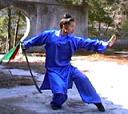|
Meihua Quan 梅花拳 literally "Plum Flower Fist".This style origins from monks
and belong to Kunlun's branch of chinese martial arts. During long time it
passed from father to son, from son to grandson, i.e. only through male
line, this was a reason to the name "fuziquan" ("fist of father and son").
Because of it although this style is known from ancient time, it spread only
at the end of Ming - beginning of Qing dynasty in counties, placed on the
joint of Hebei, Henan, Shandong and Shanxi provinces. |
 |
|
Training in Meihua Quan includes eighteen types of
traditional weapons (that is the same to said that Meihua Quan use much kind
of weapons), some of which are rarely seen weapons. Masters of Meihua Quan
have a relaxed physical look and are free from rigidity in both thought and
body postures. The practice of Meihua Quan can bring several benefits: good
health, self-defense skills, enhanced prevention and recovery from illness,
and improved mental ability.
This is the list of Weapons in Baijiazhi Meihua Quan in Taiwan:
dandao (單刀),
Qimeigun (齊眉棍),
qiang (槍, spear),
shuangdao (雙刀, double sabre),
Xiao shao gun (小哨棍),
jian (劍),
Da shao gun (大哨棍),
jiujie gangbian (九節鋼鞭),
liuxingchui (流星錘, meteor hammer),
sanjiegun (三節棍),
Meihua Guai (梅花拐),
Bishou(匕手),
dadao (大刀, alebard).
The first book about Rarely seen weapons is Genyuan (根源), that said that
Master Zou Hongyi came from Xuzhou, with a little charriot. When He
traversed the Yellow River with four disciples, He separate this object, to
do Liuxingchui (流行锤), a Fenghuolun (风火轮), some Sanjiegun (三节棍, also named Da
shaozi 大梢子), a Qijiebian (七节鞭), two Wenbang (文棒), a scale (上天梯Shang Tianti),
a Qunqiangmu (群枪母), two Xiaoguai (小拐) Liangtianchi (量天尺), & Yiben sanqiang
(一锛三枪) |













